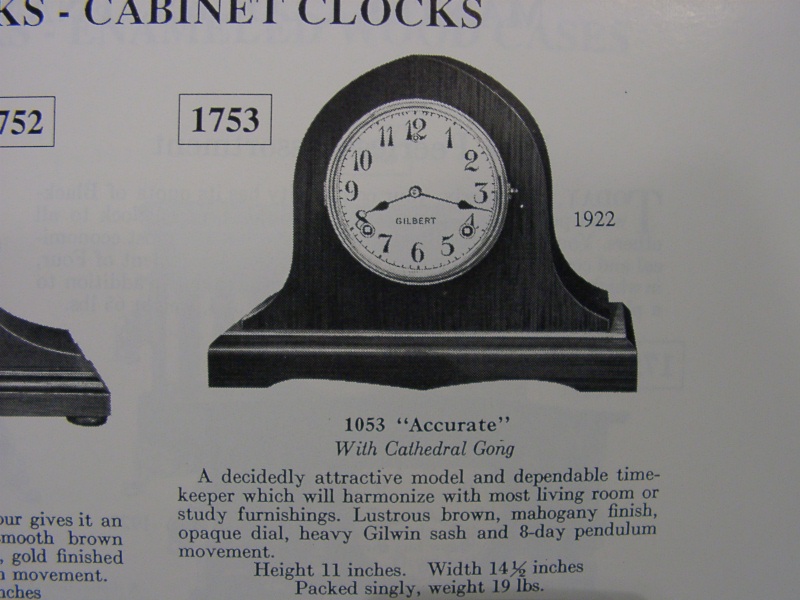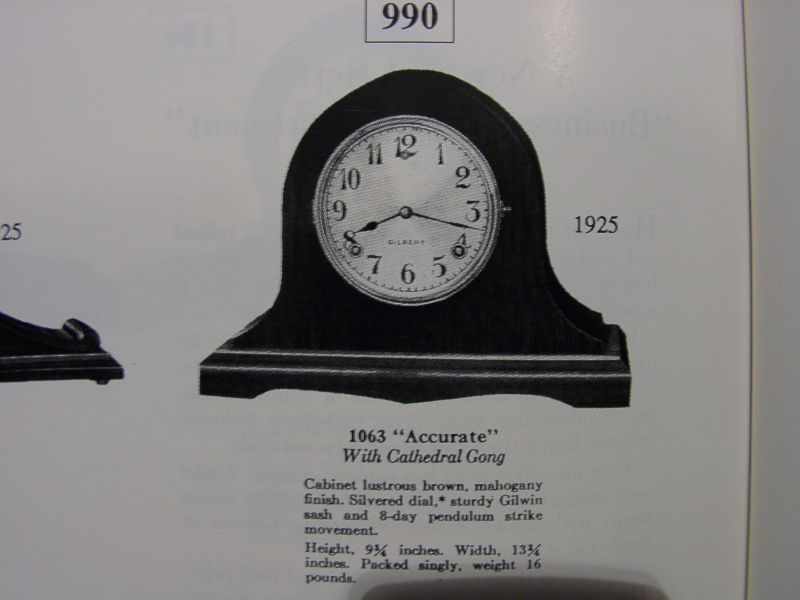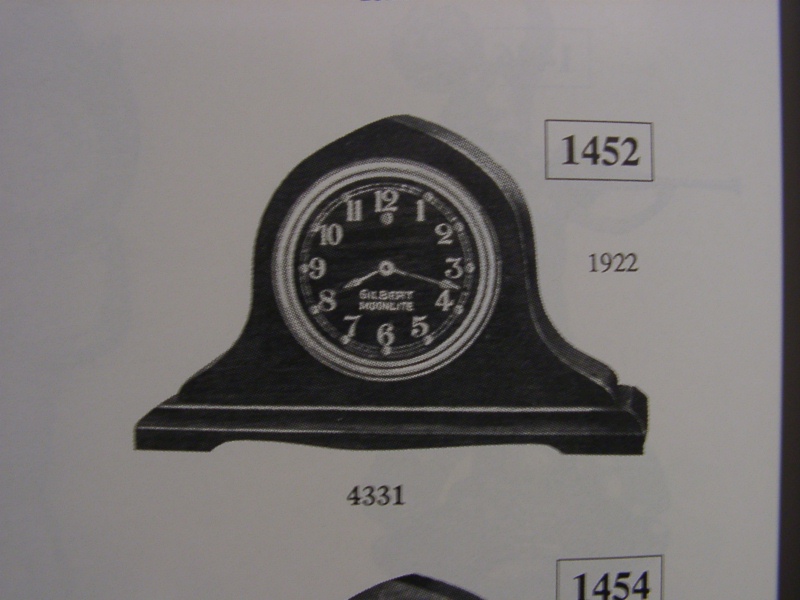
| WWT Shows | CLICK TO: Join and Support Internet Horology Club 185™ | IHC185™ Forums |

|
• Check Out Our... • • TWO Book Offer! • |
Welcome Aboard IHC185™  Internet Horology Club 185
Internet Horology Club 185  IHC185™ Discussion Site Main Page
IHC185™ Discussion Site Main Page  Technical, Shop Talk and Internet Links
Technical, Shop Talk and Internet Links  Clock Repair Questions and Answers
Clock Repair Questions and Answers  Proper dial for Gilbert "Claire" Mantle Clock c1876
Proper dial for Gilbert "Claire" Mantle Clock c1876
 Internet Horology Club 185
Internet Horology Club 185  IHC185™ Discussion Site Main Page
IHC185™ Discussion Site Main Page  Technical, Shop Talk and Internet Links
Technical, Shop Talk and Internet Links  Clock Repair Questions and Answers
Clock Repair Questions and Answers  Proper dial for Gilbert "Claire" Mantle Clock c1876
Proper dial for Gilbert "Claire" Mantle Clock c1876Go  | New Topic  | Find-Or-Search  | Notify  | Tools  | Reply to Post  |  |
I bought this mantle clock at a local auction and it needs some TLC. I took the movement out, dissassembled, cleaned, reassembled, and oiled. The clock case is pictured as I found it. It was missing the back panel, has cracking and bubbling in the front venear, and the dial seems to be a replacement. The dial is labeled "Sessions Clock Company". The clock case has cleaned up very well, revealing it's beautiful oak grain. I would like to clean it up and bring it back to it's original glory! Does anyone know what the dial should like like on this clock--or where I could find one? Any tips on repairing this clock case (making the rear panel, working with the venear, and touching up with matching stain in places)? [This message was edited by Willy on August 27, 2003 at 21:36.]  | |||
|
Willy, I'll be waiting for the picture. You mentioned "Gilbert" and "Sessions". Was the movement marked with the maker's name? If I am reading you correctly it is a Gilbert clock with a Sessions dial. Any idea of the age. A quick glance through the Gilbert book by Tran did not show a "Claire". I'll take aanother, more careful look. If I find it, I would be happy to scan a photo of the dial for you. Tom Seymour NAWCC #41293 IHC #104 IHC Exec.V.P. | ||||
|
(I could not figure out how to post more than one picture, in a post--so here is another of the label). The movement has Gilbert stamped on it, along with a date of 1876 (I'm going by memory, but I believe that is correct). The bottom of the clock case, is written with black marker "c1876", which matches the stamping on the movement plate. The label has (code word "Claire").  | ||||
|
Here is the worst part of the clock. The finish is gone on the upper side of the clock. I found pieces of metal in the wood, as if someone had dripped hot solder on it! The bottom part of the side slope of the clock appears dirty, it even has some drips of green paint on it. (Someone must have been a sloppy, careless worker above it!) I bought the clock for almost nothing at an auction. I thought this would make an inexpensive "practice" clock for me to gain some experience with. Now it is growing on me and I would like to clean it up the best I can, without ruining any antique value it may have.  | ||||
|
Willy, That looks like a great project. You will learn a lot getting that one back to showroom shine!! I found two similar models. the "Claire" was not listed in the catalogues and books that I have. The two pictures below show the same model with two different dials. One is described as "opaque" while the other has the silvered dial. I would think you have your choice. The picture is from Tran's book on Gilbert clocks. Tom Seymour NAWCC #41293 IHC #104 IHC Exec.V.P.  | ||||
|
Here is the second version. Note the numbering system. this one is not far from yours. The picture is from Tran's book on Gilbert clocks. Tom Seymour NAWCC #41293 IHC #104 IHC Exec.V.P.  | ||||
|
found one more. This one has a black dial. The picture is from Tran's book on Gilbert clocks. Tom Seymour NAWCC #41293 IHC #104 IHC Exec.V.P.  | ||||
|
Tom, Thanks for showing the types of dials that came with this clock. I might wait to find one on eBay, unless you know of a vendor that may be able to sell me one. The very top ridge of my clock case has a seam, which has pulled apart a little. The case is still very solid, but there is a gap of maybe 1-2 millimeters. I probably will leave that alone, unless the wood seam can be taken apart and re-glued. What do you think? I think that the crack and the bubbles in the front venear may be caused by the clock case expanding a little from it's seam. I'll post pictures of the clock cleaned up, once I am finished with it. It is amazing how much better it looks, just with one application of Kotton Klenser wood cleaner! | ||||
|
Willy, I would try to fix the seam in the top. Leaving it open would just let in more moisture and lead to further damage. It sounds like you are making good progress with it. Post pictures when you are ready. Tom Seymour NAWCC #41293 IHC #104 IHC Exec.V.P. | ||||
|
How would one take the seams of the clock case apart without damaging it? Is there a way to disolve the glue, in the interlocking wood joints, to pull it apart? Can you recommend a good book on doing clock case restorations? | ||||
|
Willy, I was afraid you were going to ask that!! I know that I would not want to leave the joint open, but just how to accomplish this is something I would have to ask those that are more knowledgeable of casework. I am looking with as much anticipation as you for a post that will give some specifics about how to do this. Tom Seymour NAWCC #41293 IHC #104 IHC Exec.V.P. | ||||
|
Willy, I`m not knowledgable on woodwork or refinishing but in my limited experiance I`ve found you sometimes have to "play it by ear". I once bought an old clock at what I thought was a good deal. Only problem was that some ***** had used finishing nails to tighten the case up. I contemplated how to restore this mess. Finally with the advice of an older watch/clock maker I used a punch to drive the nails in just below surface level and used wood-filler on the small indentations. After sanding the filled areas down with fine steelwool I stained the areas to match the case. Now this is no perfect job but was the best alternative I believe. The repair is only noticeable on close inspection. Had I tried to pull the nails or pull the case apart I`m sure would have made the restoration harder and probably would have looked no better and maybe worse. I`m not saying filler is the thing to do in your case but if the gap is as narrow as 1-2mms and the case is "solid" like you say that is an idea you may want to consider. The hardest part is correctly matching the stain so it isn`t noticeable. I have used acrylic paint thinned with water and even used shoe polish a time or two for minor touch-ups. You have to experiment to find the best match. Good luck! Kenny | ||||
|
Upon re-examination of this clock, it is dated 1899. It has an "E" after the year, c1899E, whatever that means?! My memory failed me--I posted that it was an 1876. I sent a borrowing request to the NAWCC library. I found two books on repairing clock cases and a DVD on veneering clocks. Hopefully the loan comes shortly. One of the books I first saw on eBay. I was tempted to buy it, but decided to borrow an edition of it from the library, and if I like it, to buy it later. | ||||
|
Willy, I believe the Sessions clock co. began in 1903. It took over the financially strapped E.N. Welch Company. Perhaps the date referred to a patent related to the movement. The sessions family were major players in the E.N. Welch Co, and probably kept the same movements, patents etc. Tom Seymour NAWCC #41293 IHC #104 IHC Exec.V.P. | ||||
|
Is the E.N. Welch company, the company that owned the Gilbert Clock Company? If so, maybe the Session's clock dial was original to this clock and not a replacement? The dial may still be a replacement, because the hole at the top of the dial seems to be hand cut. | ||||
|
Gilbert name started on clocks early in the 1820s. The name was part of several partnerships through the years, but as far as I can tell they never had anything to do with Welch. Tom Seymour NAWCC #41293 IHC #104 IHC Exec.V.P. | ||||
|
| Powered by Social Strata |
| Your request is being processed... |
|
Welcome Aboard IHC185™  Internet Horology Club 185
Internet Horology Club 185  IHC185™ Discussion Site Main Page
IHC185™ Discussion Site Main Page  Technical, Shop Talk and Internet Links
Technical, Shop Talk and Internet Links  Clock Repair Questions and Answers
Clock Repair Questions and Answers  Proper dial for Gilbert "Claire" Mantle Clock c1876
Proper dial for Gilbert "Claire" Mantle Clock c1876
 Internet Horology Club 185
Internet Horology Club 185  IHC185™ Discussion Site Main Page
IHC185™ Discussion Site Main Page  Technical, Shop Talk and Internet Links
Technical, Shop Talk and Internet Links  Clock Repair Questions and Answers
Clock Repair Questions and Answers  Proper dial for Gilbert "Claire" Mantle Clock c1876
Proper dial for Gilbert "Claire" Mantle Clock c1876©2002-2025 Internet Horology Club 185™ - Lindell V. Riddle President - All Rights Reserved Worldwide

